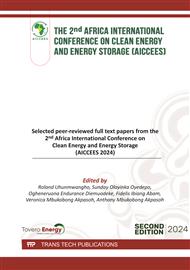p.155
p.165
p.175
p.195
p.205
p.227
p.245
p.267
p.279
Energy Efficiency, Cost-Saving Opportunities and Nearly Zero Emissions Analysis in the Residential Sector
Abstract:
This study evaluates the energy efficiency, cost-saving opportunities and nearly zero emissions for the residential sectors of Ghana and Nigeria, focusing on three household appliances: fridges, freezers and bulbs. It analyses the integration of renewable energy systems in residential households, comparing energy-efficient and non-energy-efficient scenarios in both countries. The study uses field data, existing data on RETScreen software and analytical methods to examine the energy consumption patterns of key household appliances and their impact on renewable energy system design, cost, and emissions reduction. As for the energy consumption patterns, Ghana showed higher daily usage of household appliances, with longer operational hours for fridges and freezers averaging 20.3 hours/day, while Nigeria had lower daily usage, averaging 11.8 hours/day for similar appliances. For Nigeria, the annual electricity cost in the non-energy-efficient scenario is approximately 109.69 USD, while for energy-efficient households, the cost is reduced to 79.31 USD. In Ghana, non-energy-efficient households spend around 379.97 USD annually, compared to 317.55 USD for energy-efficient homes. The results highlight the significant cost-saving opportunities of adopting energy-efficient technologies. This higher energy demand in Ghana and its higher electricity tariffs lead to greater overall consumption and higher costs. Despite similar appliance wattages, Nigeria's lower tariff results in comparatively lower energy expenses. Using the energy consumption patterns for both countries under the energy-efficient and non-energy-efficient scenarios, system sizing for solar PV and battery storage was conducted to know the economic viability of renewable energy integration through Levelized Cost of Energy (LCOE) and Net Present Value (NPV) assessments. In both scenarios, the payback period for solar PV and battery systems in Nigeria is 22 years, making it not economically viable under current electricity tariffs. In contrast, Ghana shows a payback period of 10.3 years, making solar PV systems financially viable. The RETScreen simulation examined two important scenarios for energy efficiency in Nigeria and Ghana: compact fluorescent lamps (CFLs) as the baseline and LED lighting as a proposed alternative. The results show different GHG (greenhouse gas) reduction equivalences for the number of automobiles that are not driven, the number of individuals who cut their energy use, the number of hectares of forests that absorb GHG, etc. The study's conclusions highlight the significance of energy efficiency in lowering overall energy usage, tariff rates, and expenses associated with solar and battery systems. The results have also provided more insights for both countries to create more comprehensive policies that will encourage adopting energy-efficient practices and make it cheaper for homes to integrate and use renewable energy systems.
Info:
Periodical:
Pages:
205-226
Citation:
Online since:
February 2025
Authors:
Keywords:
Price:
Сopyright:
© 2025 Trans Tech Publications Ltd. All Rights Reserved
Share:
Citation:


